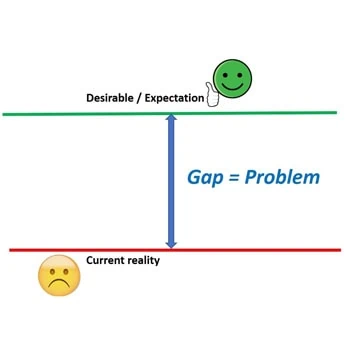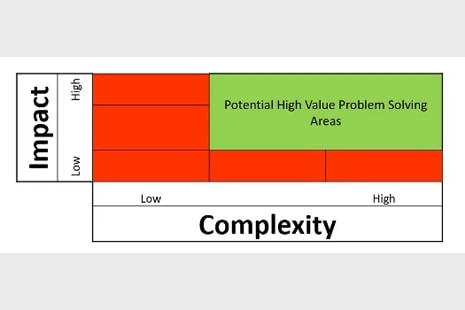Article Contents:
What is meant by problem-solving?
Problem-solving is an analytical process to solve the problem. It is more of a structured way of solving the issues.
The problem could be making decisions on complex business problems like:
Should I invest in a new business or not?
Which candidate should I recruit, candidate A or Candidate B?
How much inventory do I need to keep to manage the uncertainty?
How should I select the stock, as there are plenty of options in the market?
In all the above examples, you have a choice to go ahead with impulsive, emotional decisions or you have an option to apply a structured problem-solving process. Both choices will have an impact on the quality of decisions.
Problem-solving is a process of understanding the facts, removing unnecessary noises in the data, looking for patterns or insights or root causes, taking the right actions and implementing the actions, and looking for evidence of improvement.
Effective Problem-Solving & Decision Making
Problem-solving is a process, and decision-making is an outcome of problem-solving. Both are interrelated.
If we couple analytical problem-solving and decision-making, there is a high chance that we are making the right decisions as it is a logical or rational approach than emotional.
Why is effective problem-solving capability important?
One of the prime responsibilities of a manager or leader is making impactful decisions at the right time. The quality of decision-making will improve only when they learn the art of solving problems in a structured way, particularly for all chronic or complex business challenges.
The World Economic Forum lists problem-solving competency as one of the Top 5 competencies for the 21st century. I remembered that the forum survey reported that professionals with problem-solving capabilities would be in more demand and paid more in the job market.
As i observed, many leaders in organizations who possess excellent problem-solving capabilities will run the organization more effectively than those who lack the same.
Effective Problem-solving and decision-making are competencies each manager and leader needs to develop for professional growth.
Let us discuss the following insights. The process of problem-solving and the steps involved:
- The myth of the problem-solving approach
- The skillset required for problem-solving
- Methods of developing problem-solving competency as an individual and organization
Understanding the term "problem".
As we have been discussing problem-solving and decision-making, before going into the problem-solving process and its insights, let us have clarity on what we mean by the term “problem” in the professional context.
The term ” Problem ” is interchangeably used to refer to challenges/issues/troubles/difficulties.

What do we mean by "problem" in a professional context?
We are desiring or expecting something, and the current reality is different…there is a gap between expectation and reality, and the gap is nothing but PROBLEM.
For example,
You want to earn “X ” amount as salary, and you earn less than “X,” there is a gap… that is a problem to be solved.
You desire to grow your business by 30 % every year; in reality, you are growing only by 10 % every year. There is a gap between your desire and reality..that gap is a problem to be solved.
Likewise, you can look out any gap between the desired level and current actual status as a gap and consider it as a problem.
Why the term understanding/clarity is required?
When we have precise clarity on the definition of a problem from a professional or business perspective, it will help us narrow or define the solution objective quickly. Otherwise, we struggle to progress on the problem-solving approach.
For example,
One business head mentioned, that he has people problems in his organization. The people problem could be excess / scarcity of people or skill or behavioral or integrity related. When you express people’s problems, that would be generic, and no progress will be on it.
Later on, when we clarified the definition, he articulated that his people were loyal and good; however, he expected the team to make independent decisions in his absence. In reality, the team does not make decisions without his guidance. That is a gap that makes it easy to move to the next step in problem-solving.
When you have clarity about your expectations on any aspects and relate to existing reality, you define the problem precisely as this will help move to the next level of the problem-solving step. We need to articulate the problem or understand the problem from a desirable / expected vs. reality perspective to get clarity.
Let us discuss some other aspects of the problem-solving process.
Which problem do we solve first?
Having discussed the definition of a problem from a professional perspective, let us understand what types of problems need our attention MORE in a professional environment.
There are two types of problems we always face in the workplace. One is ad hoc in nature, which calls for quick fixing, and the solutions are predominantly emotions-based with little logic. The solutions are not necessarily preventive.

The other problem is its repetitive nature, which looks like part of our life, and this problem needs to be fixed predominately with a logical conclusion. The solutions need to be preventive. For example, at a personal level, when we get sudden health issues, we may not overthink it, and we take some pain relievers / any other pills and move on. Sometimes the solution also works well. This problem and solution are called ad hoc problem-solving.
If the same health issue is repeated frequently, the same pain reliever/ pills may not work, and it may also bring other complications. This problem is called a chronic problem. These repeated health issues or chronic problems call for structured diagnostic and treatment, which is more logical, and the solution may be a permanent cure. That is a structured problem-solving process.
In the same way, in a workplace, when we relate to our day-to-day decision-making to solve problems, it could be either an ad-hoc problem or a chronic problem.
Effective Problem-Solving & Decision Making | ad-hoc issues or tackle chronic problems?
In the realm of effective problem-solving and decision-making, which do we address, first? ad-hoc issues or tackle chronic problems in the workplace?
In some organizations, as I observed, people are always busy with delivery-related issues, which in my opinion, is a chronic problem. When the potential chronic problems are not solved and structured, they will become day-to-day firefighting problems.
As managers or leaders, our time and presence are required to solve chronic issues that need a more structured process of problem-solving, which calls for broader participation and decision-making rather than spending most on ad-hoc problems. When we are growing on the career ladder, we suppose to solve more chronic issues than managing firefighting or ad-hoc issues.
We need to be aware of our decision-making activities on whether we are solving ad-hoc or chronic problems for most of our time.
To solve chronic problems, we need to be familiar with the structured problem-solving process.
Steps involved in the structured problem-solving process
Having discussed the definition and type of problem (ad hoc or chronic) one needs to solve at the workplace, we need to learn the structured way of solving chronic problems.

What is a structured way of solving chronic problems?
Unlike emergency or firefighting situations, all chronic problems can be solved step by step logical process. We are sure to move towards permanent or practical solutions to the problem in each step of the logical process.
What does it call for?
The structured approach calls for data analytical skills, the ability to look at the big picture and micro-detail, the ability to get the insight and narrow down to the causes, decision-making skills, and more than above the ability to get the collaboration from all the stakeholders to implement the solutions.
Since structured problem-solving competency is a combination of multi-skills, only a few people take effort to learn and become masters in applying the holistic approach.
Steps in a structured problem-solving approach?
Since there are many problem-solving processes available in the market like Six sigma, QC approach, A3,8D, all the approaches lead to solving the chronic problem in a structured way. The tools and formats may be different, and it is up to the individual to learn and master any approach.
Ultimately all the approaches consist of the following steps:
- Prioritizing the problem
- Defining the objective
- Collecting the data/ facts
- Understanding the insights from data /removal of noises
- Converging to causes
- Articulating the actions -short/medium / long term perspective
- Taking action and checking the effectiveness
Developing a comprehensive understanding of the problem-solving process as a capability will enhance your managerial skill to get things done and career growth.
Let us discuss some of the insights in each step.
How do we prioritize problems?
As we discussed the steps in structured problem solving, in this series, let us discuss some of the insights in each step as this helps the Managers/ Leaders to get a perspective on the practical dilemma in problem-solving.
One of the challenges for most managers and business leaders is “How to prioritize the problems in the organization ?”
The question arises as the organization has many problems, and almost all work on one or other problems. Still, in the end, the quantum of the problem remains the same, or the organizational objectives are not met consistently. This scenario is most common in an organization where people are busy managing a day-to-day crisis.
Some leaders are good at prioritizing problems, channeling all the resources into solving those problems, and finally making an impact on business, thereby creating a pleasant work environment. This competency is required for every leader and can be learned as well.
One method of prioritizing the problems in the organization is through Impact Vs. Complexity.
Problems - Impact vs Complexity:
Impact means if the problem is resolved, it will improve business performance like delivery, revenue, customer retention, morale etc.
Complexity means the solution calls for many stakeholders or cross-functional teams and the problem arises due to a variety of reasons like people, equipment, money, communication issues etc. Generally, a day-to-day crisis management methodology cannot solve the complexity.

For example,
As a leader, choosing a “customer delivery problem” as a priority for solving through a structured approach will significantly impact the organization. The delivery problems also call for involving cross-functional stakeholders and addressing many areas.
When you choose the high impact vs. high complexity problem and involve many stakeholders as part of the structured problem solving and delegate in submodules, eventually, the solutions will make the organization have a high impact on business performance and the morale of the people.
Alternatively, when we choose low impact and less or more complex problems, neither the organization will realize many benefits nor the problems deserve much attention from many.
As Managers / Leaders, we need to have clarity on where to focus for higher impact!
Why should we define an Objective clearly before solving a problem?
As we discussed the insights in structured problem-solving methodology, first, we discussed how the business managers can choose or prioritize the problem in the organization. After selecting the problem, the next step is ” Defining the objectives clearly.”
What is meant by Objective?
Objective means aim or goal or target or where our effort should go towards solving the problem.
For example,” Reduce the customer complaints by 50%” is an objective, goal, or target.

Why should we define the Objective clearly?
First, it gives clarity to all that we intend to solve.
Second, it sets the boundary condition or scope under which we are going to work.
Third, it improves the focus as we define the end and the scope clearly at the beginning.
Without a clear objective definition, the team may divert the focus in many sub-problems related to the main problem and go endlessly without achieving the goal.
For example,
As a business head, you set the goal to increase business profitability by 25% in the next financial year.
You may have multiple options to achieve this goal, and you can pursue all the possibilities. In the process, you may be chasing many options, achieving the goal, or failing to achieve it.
When you define your Objective clearly, like by specifying the result and the focus area, like
to increase profitability by 25 % by introducing new customers or new products, it sets sharp direction and clarity to you and the team on which path you want to pursue. By establishing a clear objective, you are certain to focus your energy on building new products or new customers, and most likely, you may achieve the result.
Likewise, instead of defining objectives like reducing rejection by 50 %, if you define clearly, like reducing the supply base rejection by 50 % within a three-month timeline, you are giving more clarity and direction to the team, where they are supposed to focus. Otherwise, the team can choose to work on supply rejections, inhouse manufacturing rejection, customer rejection, and so on…
The point is that articulating the objectives clearly helps to reduce ambiguity and improve the focus.
Suppose managers and leaders learn to articulate the objectives with a clear target, timeline, scope, which will likely improve the team’s effectiveness in solving the problems. Also, it helps them become better problem solvers in their careers.
To summarize
“Effective Problem-Solving & Decision Making” is a cornerstone for business leaders seeking structured approaches to tackle complex challenges.
By distinguishing between chronic issues and ad-hoc fixes, the blog underscores the significance of a logical, data-driven resolution pathway over emotion-based decision-making. It also stresses the necessity of defining problems clearly to narrow down solutions and expounds on the step-by-step logic of structured problem-solving, a skill highly valued in the professional sphere. Moreover, the article navigates the prioritization of issues, emphasizing on addressing high-impact, complex problems through cross-functional collaboration. With decision-making seen as an outcome of problem-solving, the blog positions effective problem resolution as pivotal to managerial prowess and organizational success.



